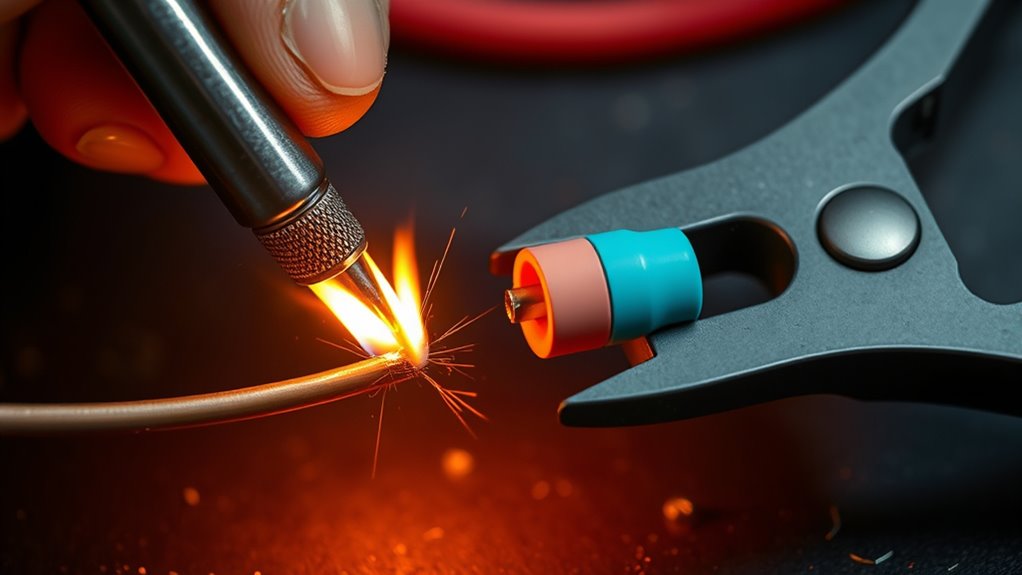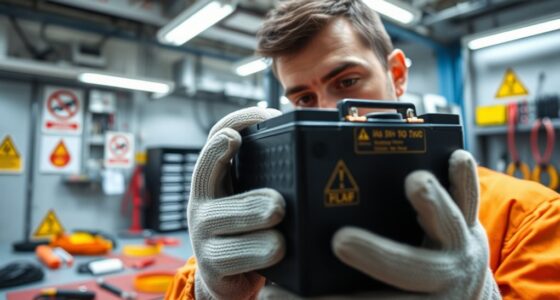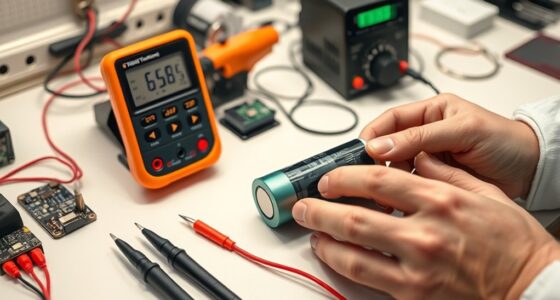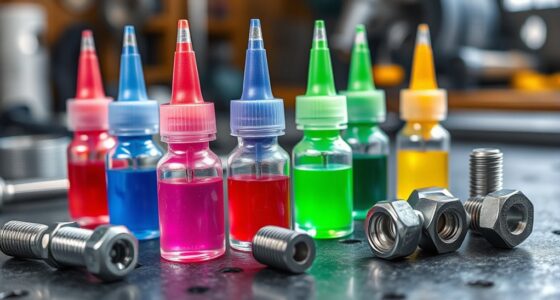When choosing between soldering and crimping for wiring, consider your needs for speed, precision, and durability. Soldering offers a more permanent, detailed connection suited for delicate work but takes more time and skill. Crimping is faster, easier, especially for larger wires, and provides a reliable mechanical and electrical bond. Both methods require proper insulation to guarantee safety and longevity. Keep exploring to discover which method best fits your project and how to do it right.
Key Takeaways
- Soldering provides precise, durable connections ideal for delicate or detailed wiring work.
- Crimping offers faster, reliable, and secure connections suitable for bulk or larger gauge wires.
- Soldering requires skill and time but ensures a permanent bond, while crimping is quicker and easier for field use.
- Proper insulation is essential in both methods to prevent shorts and ensure safety.
- Choice depends on application: soldering for precision and durability, crimping for speed and large gauge wiring.

When choosing between soldering and crimping for electrical connections, understanding their differences is crucial. Both methods have their strengths and limitations, but your choice ultimately depends on your project’s requirements, especially regarding wire gauge compatibility and insulation techniques. Soldering involves melting a metal alloy to join wires, creating a solid, conductive connection. It’s ideal for delicate or detailed work where precision matters. However, soldering requires careful attention to wire gauge compatibility; thinner wires may heat up too quickly, risking damage, while thicker wires need more heat and longer application. Proper insulation techniques are also important here—after soldering, you should insulate the joint thoroughly to prevent shorts or corrosion. Using heat shrink tubing or electrical tape ensures the connection remains protected against moisture and mechanical stress. Additionally, soldering can be more susceptible to fatigue over time if not done properly, especially in environments with vibrations. Crimping, on the other hand, uses a specialized tool to compress a metal connector around the wire, forming a secure mechanical and electrical bond. It’s particularly effective for larger wire gauges, where soldering might be cumbersome or less reliable. With crimping, wire gauge compatibility is straightforward because connectors come in specific sizes designed for certain gauges. If you match the correct connector to your wire gauge, you’ll achieve a strong, consistent connection. Insulation techniques in crimping involve using insulated crimp terminals that have a built-in sleeve or collar. This design simplifies insulation, as the terminal itself provides a protective barrier around the connection, reducing the risk of shorts and ensuring mechanical stability. When considering ease and speed, crimping generally offers a quicker solution, especially for bulk wiring or repetitive tasks. It doesn’t require the same level of skill or equipment as soldering, making it suitable for fieldwork or situations where you need reliable results fast. Soldering might take longer and demands more practice to perfect, but it can provide a more permanent connection, especially in applications where vibrations or movement could weaken a crimped joint over time. Both methods, however, benefit from proper insulation techniques—whether it’s sealing a soldered joint with heat shrink or ensuring crimped connections are well-insulated with appropriate terminal covers. Moreover, understanding the different applications of soldering and crimping can help you choose the best method for your specific project.
Frequently Asked Questions
Which Method Is More Environmentally Friendly?
You’ll find that crimping is more environmentally friendly since it generates less material waste and has higher recycling potential. Soldering often involves additional materials like flux and solder, which can be harder to recycle and create more waste. Crimping uses less material and produces cleaner connections, making it easier to reuse and recycle components afterward. So, for a greener approach, crimping generally offers a more sustainable option.
How Does Temperature Affect Soldering Quality?
You’ll find that temperature critically impacts soldering quality through heat transfer and thermal expansion. If you apply too much heat, it causes excessive thermal expansion, which can weaken the joint or damage components. Too little heat results in poor bonding due to insufficient melting of solder. Maintaining a suitable temperature ensures proper heat transfer, creating strong, reliable connections without damaging sensitive parts, ultimately improving your soldering results.
Can Crimping Be Used for High-Vibration Environments?
Yes, crimping can be used for high-vibration environments if you choose quality connectors designed for vibration stability. Properly crimped connections offer excellent vibration stability and connection durability, making them suitable for such conditions. You should guarantee the crimping tool and connectors are compatible and correctly applied, which helps maintain a solid connection despite constant movement or shock, ultimately providing reliable performance in demanding environments.
What Are the Safety Risks Associated With Soldering?
When you solder, you face safety hazards like burns from hot solder and equipment, and the risk of electrical shock if proper precautions aren’t taken. Always work in a well-ventilated area to avoid inhaling fumes, wear protective gloves, and make sure your equipment is properly grounded. Careful handling reduces these risks, protecting you from potential injuries and ensuring a safer soldering process.
How Do Costs Compare Over Long-Term Usage?
Over the long term, crimping generally proves more cost-effective due to its material durability and faster installation speed. Crimped connections are less prone to corrosion and require less maintenance, saving you money over time. Soldering, while initially cheaper in materials, may need repairs or rework later, increasing costs. You’ll find that crimping’s efficiency and durability make it the more economical choice for long-term wiring projects.
Conclusion
Whether you choose soldering or crimping, remember that each method has its strengths. Think of soldering like weaving a tight, seamless fabric—strong and reliable when done right. Crimping, on the other hand, is like fastening with a sturdy clip—quick and efficient. I once watched a technician master both techniques, realizing that knowing when to switch is like having a versatile toolbox. Ultimately, your choice depends on your project’s needs and your skill.









